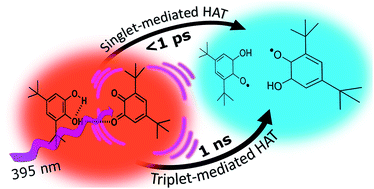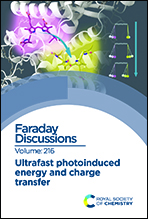Probing eumelanin photoprotection using a catechol:quinone heterodimer model system†
Abstract
Eumelanin is a natural pigment with photoprotective and radical scavenging characteristics, which are vital for a multitude of living organisms. However, the molecular mechanisms behind these functions remain obscure, in part because eumelanin is a heterogeneous polymer composed of a complex assortment of structural and chemical domains. Despite uncertainty about its precise structure, the functional units of eumelanin are thought to include quinones in various oxidation states. Here, we investigate the photochemistry of a catechol : o-quinone heterodimer as a model system for uncovering the photoprotective roots of eumelanin. Ultrafast transient absorption measurements in the UV to near-IR spectral regions are used to identify the photochemical processes that follow selective excitation of the o-quinone in the heterodimer using 395 nm light. We find that both singlet and triplet o-quinone excited states induce hydrogen atom transfer from the catechol, forming semiquinone radical pairs that persist beyond 2.5 ns, which is the upper time limit accessible by our instrument. Furthermore, the hydrogen atom transfer reaction was found to occur 1000 times faster via the singlet channel. Excited state pathways such as these may be important in eumelanin, where similar hydrogen-bonded interfaces are believed to exist between catechol and o-quinone functional groups.

- This article is part of the themed collection: Ultrafast photoinduced energy and charge transfer


 Please wait while we load your content...
Please wait while we load your content...